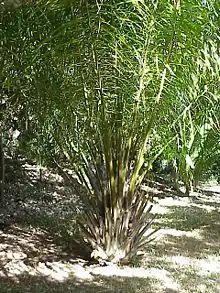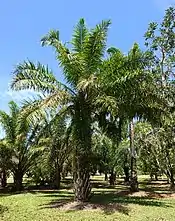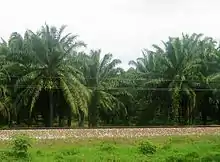Elaeis
Elaeis (from Greek 'oil') is a genus of palms containing two species, called oil palms. They are used in commercial agriculture in the production of palm oil. The African oil palm Elaeis guineensis (the species name guineensis referring to its country of origin) is the principal source of palm oil. It is native to west and southwest Africa, occurring between Angola and Gambia. The American oil palm Elaeis oleifera (from Latin oleifer 'oil-producing')[2] is native to tropical Central and South America,[3] and is used locally for oil production.
| Elaeis | |
|---|---|
 | |
| African Oil Palm (Elaeis guineensis) | |
| Scientific classification | |
| Kingdom: | Plantae |
| Clade: | Tracheophytes |
| Clade: | Angiosperms |
| Clade: | Monocots |
| Clade: | Commelinids |
| Order: | Arecales |
| Family: | Arecaceae |
| Subfamily: | Arecoideae |
| Tribe: | Cocoseae |
| Genus: | Elaeis Jacq. |
| Species | |
| |
| Synonyms[1] | |
Description
Mature palms are single-stemmed, and can grow well over 20 m (66 ft) tall. The leaves are pinnate, and reach between 3–5 m (10–16 ft) long. The flowers are produced in dense clusters; each individual flower is small, with three sepals and three petals.
The palm fruit is reddish, about the size of a large plum, and grows in large bunches. Each fruit is made up of an oily, fleshy outer layer (the pericarp), with a single seed (the palm kernel), also rich in oil.
Species
The two species, E. guineensis and E. oleifera can produce fertile hybrids. The genome of E. guineensis has been sequenced, which has important implications for breeding improved strains of the crop plants.[4]
| Image | Name | Common name | Distribution |
|---|---|---|---|
 | Elaeis guineensis Jacq. | African oil palm or macaw-fat | west and southwest Africa, specifically the area between Angola and The Gambia |
 | Elaeis oleifera (Kunth) Cortés | American oil palm | South and Central America from Honduras to northern Brazil |
Commercial palm oil cultivation
Since palm oil contains more saturated fats than oils made from canola, corn, linseed, soybeans, safflower, and sunflowers, it can withstand extreme deep-frying heat and resists oxidation.[5] It contains no trans fat, and its use in food has increased as food-labelling laws have changed to specify trans fat content. Oil from Elaeis guineensis is also used as biofuel.
Human use of oil palms may date back to about 5,000 years in coastal west Africa. Palm oil was also discovered in the late 19th century by archaeologists in a tomb at Abydos dating back to 3000 BCE.[6] It is thought that Arab traders brought the oil palm to Egypt.
Elaeis guineensis is now extensively cultivated in tropical countries outside Africa, particularly Malaysia and Indonesia which together produce most of the world supply.
Controversy
Palm oil is typically considered the most controversial of the cooking oils - for both health and environmental reasons.[7] Palm oil plantations are under increasing scrutiny for social and environmental harm, particularly because rainforests with high biodiversity are destroyed, greenhouse gas output is increased, and because people are displaced by unscrupulous palm-oil enterprises and traditional livelihoods are negatively impacted. Especially in Indonesia, there is also growing pressure for palm oil producers to prove that they are not harming rare animals in the cultivation process.[8]
In 2018 a Christmas TV advertisement by UK supermarket chain Iceland Foods Ltd, produced by Greenpeace, was banned by the UK advertising watchdog Clearcast,[9] as it was deemed too political. Iceland Foods had committed to banning palm oil from its own-brand products by the end of 2018.[10]
See also
References
- "World Checklist of Selected Plant Families: Royal Botanic Gardens, Kew". wcsp.science.kew.org.
- Gledhill, David (2008). The Name of Plants (4 ed.). Cambridge: University Press. p. 279.
- Collins Guide to Tropical Plants, ISBN 0-00-219112-1
- Singh, R.; Ong-Abdullah, M.; Low, E.-T.L.; Manaf, M.A.A.; Rosli, R.; Nookiah, R.; Ooi, L.C.-L.; Ooi, S.-E.; Chan, K.-L.; Halim, M.A.; Azizi, N.; Nagappan, J.; Bacher, B.; Lakey, N.; Smith, S.W.; He, D.; Hogan, M.; Budiman, M.A.; Lee, E.K.; DeSalle, R.; Kudrna, D.; Goicoechea, J.L.; Wing, R.A.; Wilson, R.K.; Fulton, R.S.; Ordway, J.M.; Martienssen, R.A.; Sambanthamurthi, R. (2013). "Oil palm genome sequence reveals divergence of interfertile species in Old and New worlds". Nature. 500 (7462): 335–339. doi:10.1038/nature12309. PMC 3929164. PMID 23883927.
- De Marco, Elena; Savarese, Maria; Parisini, Cristina; Battimo, Ilaria; Falco, Salvatore; Sacchi, Raffaele (2007). "Frying performance of a sunflower/palm oil blend in comparison with pure palm oil". European Journal of Lipid Science and Technology. 109 (3): 237–246. doi:10.1002/ejlt.200600192.
- Kiple, Kenneth F.; Conee Ornelas, Kriemhild, eds. (2000). The Cambridge World History of Food. Cambridge University Press. ISBN 0521402166. Archived from the original on 20 October 2012. Retrieved 30 August 2012.
- "Why palm oil is so controversial". The Independent. August 24, 2018.
- "Palm Oil Plantations Are Blamed For Many Evils. But Change Is Coming". NPR.org. Retrieved 2017-07-19.
- "Opinion: Iceland's Christmas advert ban for being 'too political' is heartless". The Independent. November 9, 2018.
- "Iceland supermarkets to ban palm oil in own-brand products". April 10, 2018 – via www.bbc.co.uk.
External links
 Media related to Elaeis at Wikimedia Commons
Media related to Elaeis at Wikimedia Commons- "Oil palm - Diseases and Pests, Description, Uses, Propagation". Penn State PlantVillage. Retrieved 2020-11-19.
- "AESA BASED IPM PACKAGE - OIL PALM" (PDF). Directorate of Plant Protection, Quarantine, and Storage and National Institute of Plant Health Management.
- "NATIONAL FOOD SECURITY MISSION - OILPALM". Andhra Pradesh Horticulture Department. Retrieved 2020-11-19.
